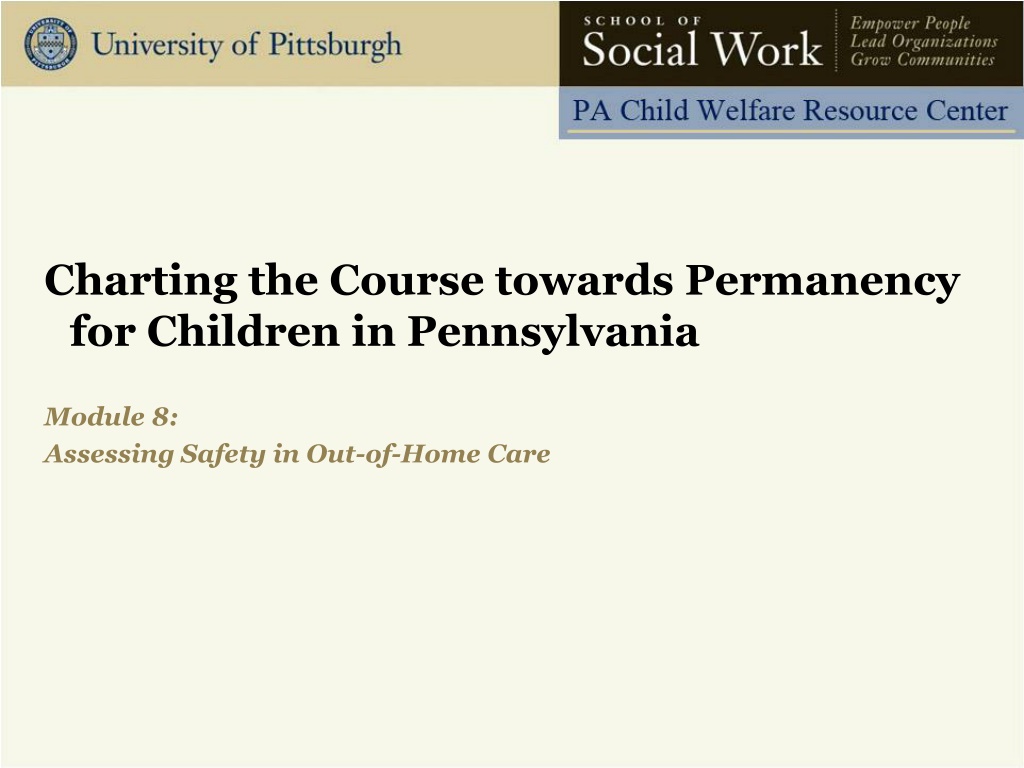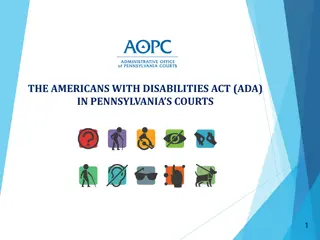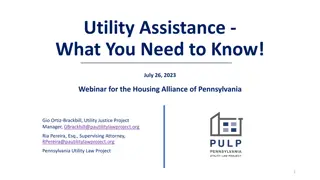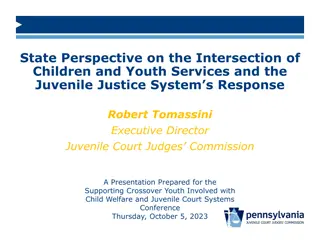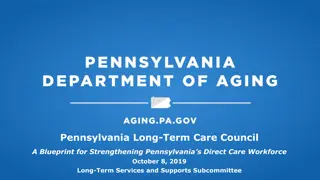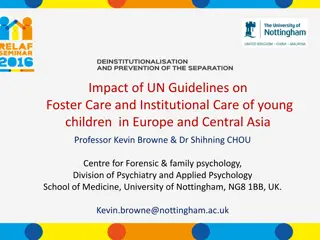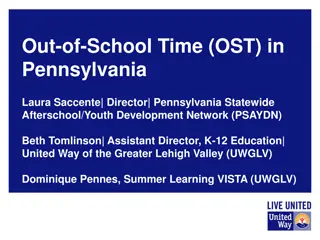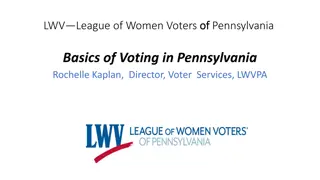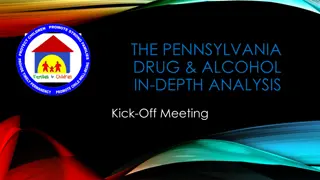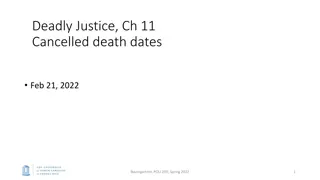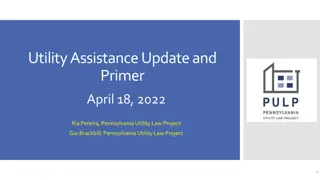Assessing Safety in Out-of-Home Care for Children in Pennsylvania
This module focuses on evaluating safety in out-of-home care for children in Pennsylvania by exploring characteristics of safety and a safe environment. It delves into assessing how children and caregivers behave, the family dynamics, and community connections to sustain safety. The goal is to equip workers with the skills to ensure children's safety in kinship care, foster or pre-adoptive homes, and during respite care, emphasizing periodic safety reassessment.
Download Presentation

Please find below an Image/Link to download the presentation.
The content on the website is provided AS IS for your information and personal use only. It may not be sold, licensed, or shared on other websites without obtaining consent from the author. Download presentation by click this link. If you encounter any issues during the download, it is possible that the publisher has removed the file from their server.
E N D
Presentation Transcript
Charting the Course towards Permanency for Children in Pennsylvania Module 8: Assessing Safety in Out-of-Home Care
Ground Rules Be on time Sign/initial the sign-in sheet each day Provide constructive/motivational feedback Be respectful Take risks Ask questions No cell phones/text messaging The Pennsylvania Child Welfare Resource Center Module 8: Assessing Safety in Out-of-Home Care 2
Name Tents Unit/Department County Name Length of time in current position What is one thing you do now to make sure children are safe in out-of-home care? The Pennsylvania Child Welfare Resource Center Module 8: Assessing Safety in Out-of-Home Care 3
Characteristics of Safety & A Safe Environment An absence of or control of threats of severe harm Presence of caregiver Protective Capacities A safe home is experienced as a refuge Perceived and felt security Confidence in consistency The Pennsylvania Child Welfare Resource Center Module 8: Assessing Safety in Out-of-Home Care 4
Information Explored to Identify Characteristics of Safety & A Safe Environment How the children are behaving in the home How caregivers are performing How the family is operating The caregiver(s) capacity to sustain continued safety How community connections sustain continued safety The Pennsylvania Child Welfare Resource Center Module 8: Assessing Safety in Out-of-Home Care 5
Goal & Purpose of the Training To provide a specific approach for workers to assess, judge, and determine that a child will be safe when first placed with a kinship care provider, in a foster or pre- adoptive home, and in respite, that safety will continue and that safety will be reaffirmed periodically during a child s stay in out-of-home care. The Pennsylvania Child Welfare Resource Center Module 8: Assessing Safety in Out-of-Home Care 6
Overall Learning Objectives Identify and provide rationale for standards of care associated with kin (formal and informal) and foster care and evaluate the effect of our beliefs and perceptions on safety in out-of-home care. Learn the Pennsylvania specific approach designed to assess, confirm, and maintain child safety in out-of- home care. Recognize the nature and importance of quality visitation with children in out-of-home care as a basis for assessing their safety as well as for attending to other critical needs. The Pennsylvania Child Welfare Resource Center Module 8: Assessing Safety in Out-of-Home Care 7
Overall Learning Objectives, contd Connect information collection skills and methods related to critical attributes of safety in out-of-home care. Learn to complete an assessment and analysis of attributes of a safe out-of-home care setting. Identify the critical thinking required to reach conclusions and make decisions based on an assessment of safety in out-of-home care. The Pennsylvania Child Welfare Resource Center Module 8: Assessing Safety in Out-of-Home Care 8
Whats In It For Me? The Pennsylvania Child Welfare Resource Center Module 8: Assessing Safety in Out-of-Home Care 9
Agenda Day 1 Welcome & Introductions Defining Out-of-Home Care Knowing the Child to be Placed Present Danger Indicators of Safety in Out-of-Home Care Day 2 Focused Information Collection through Quality Visitation Analyzing Safety Information & Making the Safety Decision Workshop Closure & Evaluations The Pennsylvania Child Welfare Resource Center Module 8: Assessing Safety in Out-of-Home Care 10
Tuning In Activity Agree Disagree The Pennsylvania Child Welfare Resource Center Module 8: Assessing Safety in Out-of-Home Care 11
Glossary of Terms The Pennsylvania Child Welfare Resource Center Module 8: Assessing Safety in Out-of-Home Care 12
Safety in Out-of-Home Care A family and home situation where there is an absence of perceived or actual threats, a refuge exists, and is experienced, family members have perceptions and feelings of security and there is confidence in consistency. The Pennsylvania Child Welfare Resource Center Module 8: Assessing Safety in Out-of-Home Care 13
Out-of-Home Care 24-hour care and supervision of a child outside of the home from which the child was removed; out-of- home care includes both informal and formal care arrangements. The Pennsylvania Child Welfare Resource Center Module 8: Assessing Safety in Out-of-Home Care 14
Formal Care Required in situations in which the County Children and Youth Agency has legal and physical custody of the child and places the child in an emergency caregiver s home that has temporary approval from a state- licensed foster care agency, or in a resource home fully approved by a state-licensed foster care or adoption agency. The Pennsylvania Child Welfare Resource Center Module 8: Assessing Safety in Out-of-Home Care 15
Informal Care Situations in which a child who is not in County Children and Youth Agency custody goes to live with an alternate caregiver on a temporary basis when Safety Threats are present and the child is unable to continue residing with the caregiver(s) of origin. The Pennsylvania Child Welfare Resource Center Module 8: Assessing Safety in Out-of-Home Care 16
Informal Care, contd These arrangements include those: made by parents/guardians prior to County Children and Youth Agency involvement or agreed upon jointly between the parents/guardians and the County Children and Youth Agency when the situation occurs during the course of County Children and Youth Agency involvement. The Pennsylvania Child Welfare Resource Center Module 8: Assessing Safety in Out-of-Home Care 17
Global Look at The Assessing Safety in Out-of-Home Care Model The Pennsylvania Child Welfare Resource Center Module 8: Assessing Safety in Out-of-Home Care 18
Steps to Assess Safety in Out-of-Home Care Step 1: Know the Child to be Placed Step 2: Provider Selection Step 3: Present Danger Assessment and safety determination (First Encounter - Provider Interview) Step 4: Confirm a safe placement setting (Within 60 days, or two months, from the date of placement) Step 5: Monitor for stability and any changes that could pose a threat to child safety (within 180 days, or six months from the previously confirmation of a safe placement setting) The Pennsylvania Child Welfare Resource Center Module 8: Assessing Safety in Out-of-Home Care 19
Step 1: Knowing the Child to be Placed Does the child contribute in some way to the threat of harm that is present in his or her own home? Does the child possess any medical or other special needs? Is the child particularly vulnerable? Does the child exhibit sexualized behavior? Does the child exhibit aggressive behavior? Is the child fearful? What is the child s perception of the placement? Are their sibling group considerations that must take place? The Pennsylvania Child Welfare Resource Center Module 8: Assessing Safety in Out-of-Home Care 20
Step 2: Provider Selection Formal Living Arrangements Review the total database available concerning a prospective foster home: home studies, case records, current and previous workers. Evaluate evidence of minimum care, maltreatment or risk of maltreatment, threats of harm, successful care and current and past placements. The Pennsylvania Child Welfare Resource Center Module 8: Assessing Safety in Out-of-Home Care 21
Step 2: Provider Selection, contd Informal Living Arrangements Complete background checks and other clearances as required. Check agency information sources: central registry and agency records. Consider other children and adults in the home. The Pennsylvania Child Welfare Resource Center Module 8: Assessing Safety in Out-of-Home Care 22
Step 3: Present Danger Assessment and Initial Safety Determination First encounter and interview with provider. Consider others in the home/impact of them on the placed child and child s impact on them. Consider immediate safety issues. Decide if the provider home is safe or unsafe. If minor changes can eliminate threats go for those quick fixes. Otherwise, if not safe, another placement is needed. The Pennsylvania Child Welfare Resource Center Module 8: Assessing Safety in Out-of-Home Care 23
Step 4: Confirm a Safe Placement Setting Within 60 days or two months from placement, conduct the first comprehensive assessment by conducting as many face-to-face and phone contacts as possible with the placed child and placement family to gather information. Monitor placed child s family Safety Plan. If there are concerning circumstances, put supports in place (not a Safety Plan). Make decision about safety of the child in this setting. After placement, safety is assessed at every contact. The Pennsylvania Child Welfare Resource Center Module 8: Assessing Safety in Out-of-Home Care 24
Step 5: Monitor for Stability Over the next 180 days or six months from the previously confirmation of a safe placement setting. Confirm that conditions that create safety for child continue. Monitor for any changes that could pose a threat to child safety Remember, safety is assessed at every contact. The Pennsylvania Child Welfare Resource Center Module 8: Assessing Safety in Out-of-Home Care 25
Action Planning Take a moment to identify: Something new I learned Something I need to know more about Something I will apply to my job The Pennsylvania Child Welfare Resource Center Module 8: Assessing Safety in Out-of-Home Care 26
Knowing the Child to be Placed The Pennsylvania Child Welfare Resource Center Module 8: Assessing Safety in Out-of-Home Care 27
Incidence of Children Entering Out-of-Home Placement Children under six represent the largest group of children entering out-of-home placement. Children under five are the largest and fastest growing subpopulation involved in the child welfare system. Children under four represent 31.9 percent of all children experiencing child maltreatment. Children under six represent 34 percent of all children in out-of-home placement. Center for the Study of Social Policy, 2007 The Pennsylvania Child Welfare Resource Center Module 8: Assessing Safety in Out-of-Home Care 28
Incidence of Children Experiencing Trauma More than 60 percent of children surveyed by the Center for Disease Control in 2009 were determined to have been exposed to violence within the past year. Children experiencing six or more traumatic events are likely to have an average lifespan of 19 years shorter than other children who do not suffer the same degree of trauma. The Pennsylvania Child Welfare Resource Center Module 8: Assessing Safety in Out-of-Home Care 29
Incidence of Children Experiencing Trauma, cont d Adverse childhood experiences have a significant negative impact on later adult functioning. The greater the number of exposures to trauma in childhood results in the greater likelihood of adult health risk behaviors, poor health status, and disease. Centers for Disease Control and Prevention. Atlanta: CDC, (2006). Adverse Childhood Experiences Study Available from: http://www.cdc.gov/nccdphp/ace/index.htm. The Pennsylvania Child Welfare Resource Center Module 8: Assessing Safety in Out-of-Home Care 30
Grief Reactions to Separation / Loss Shock Anger/Protest Bargaining Depression Resolution The Pennsylvania Child Welfare Resource Center Module 8: Assessing Safety in Out-of-Home Care 31
Purposes of Child Preparation for Placement Alleviating anxieties/reducing stress. Assessing children s strengths and needs and communicating this information to caregivers. Establishing supportive relationships with children. Connecting new caregivers and children to ease transition. Providing supportive services. The Pennsylvania Child Welfare Resource Center Module 8: Assessing Safety in Out-of-Home Care 32
Speaking to Children about Placement Discussion points, including use of specific interactional skills such as: Tuning in to Self, Tuning in to Others, Reaching Inside of Silences, Reaching for Feedback, etc. Pay particular attention to the child s developmental stage. Key points for consideration in preparing the child including independent living concerns for 16-year-old Carley. The Pennsylvania Child Welfare Resource Center Module 8: Assessing Safety in Out-of-Home Care 33
Action Planning Take a moment to identify: Something new I learned Something I need to know more about Something I will apply to my job The Pennsylvania Child Welfare Resource Center Module 8: Assessing Safety in Out-of-Home Care 34
Principles for Choosing an Appropriate Placement Setting If non-custodial parent can provide a safe home, placement is not necessary. Consider Kinship Care as a 1st option. Include the family in the selection of the placement setting and in pre-placement visits. The Pennsylvania Child Welfare Resource Center Module 8: Assessing Safety in Out-of-Home Care 35
Principles for Choosing an Appropriate Placement Setting, cont d Place the child(ren) in a home/facility where they can continue to attend the same school. Carefully assess the child s needs prior to choosing the placement. Select the substitute caregiver based upon their capability to meet the child's special needs. The Pennsylvania Child Welfare Resource Center Module 8: Assessing Safety in Out-of-Home Care 36
Placement Considerations in Pennsylvania Policy Registry Relatives/Kin Least Restrictive Education Considered The Pennsylvania Child Welfare Resource Center Module 8: Assessing Safety in Out-of-Home Care 37
PRESENT DANGER The Pennsylvania Child Welfare Resource Center Module 8: Assessing Safety in Out-of-Home Care 38
Present Danger Defined An immediate, significant, and clearly observable family condition (severe harm or threat of severe harm) occurring to a child/youth in the present tense, endangering or threatening to endanger a child, and therefore requiring prompt response. The Pennsylvania Child Welfare Resource Center Module 8: Assessing Safety in Out-of-Home Care 39
Assessing Present Danger Identify current danger. Identify immediate threat of danger. Confirm current danger or threat of danger as necessary by fully exploring and understanding the nature of the harm or threat of harm. If after exploration you determine that Present Danger exists, respond/take action accordingly e.g., address the threat, avoid the home as a placement, or locate the child to another home (if the child is already placed). The Pennsylvania Child Welfare Resource Center Module 8: Assessing Safety in Out-of-Home Care 40
Safety Responsibility Standard In no instance should a child be placed or remain in a kin or foster placement if Present Danger is apparent and cannot be immediately addressed. The Pennsylvania Child Welfare Resource Center Module 8: Assessing Safety in Out-of-Home Care 41
PRESENT DANGER: DEFINITIONS AND EXAMPLES The Pennsylvania Child Welfare Resource Center Module 8: Assessing Safety in Out-of-Home Care 42
Present Danger in Out-of-Home Care Out-of-home caregiver(s) or others in the home are acting violently or out of control. Out-of-home caregiver(s) describes or acts toward the child in predominantly negative terms or has extremely unrealistic expectations. The out-of-home caregiver(s) communicates or behaves in ways that suggest that they may fail to protect child(ren) from serious harm or threatened harm by other family members, other household members, or others having regular access to the child(ren). The Pennsylvania Child Welfare Resource Center Module 8: Assessing Safety in Out-of-Home Care 43
Present Danger in Out-of-Home Care, contd The out-of-home caregiver(s)/family refuses access to the child, or there is reason to believe that the family is about to flee. Out-of-home caregiver(s) is unwilling or unable to meet the child s immediate needs for food, clothing, or shelter. Out-of-home caregiver(s) is unwilling or unable to meet medical needs including their own, other placed children, or children to be placed. Out-of-home caregiver(s) has not, will not, or is unable to provide supervision necessary to protect child from potentially serious harm. The Pennsylvania Child Welfare Resource Center Module 8: Assessing Safety in Out-of-Home Care 44
Present Danger in Out-of-Home Care, contd Child is unusually fearful/anxious of home situation. Out-of-home caregiver(s) has previously maltreated a child, and the severity of the maltreatment or the caregiver s response to the previous incident(s) suggests that safety may be an immediate concern. The physical living conditions are hazardous and immediately threatening. The out-of-home caregiver(s) drug or alcohol use seriously affects his/her ability to supervise, protect, or care for the child. The Pennsylvania Child Welfare Resource Center Module 8: Assessing Safety in Out-of-Home Care 45
Present Danger in Out-of-Home Care, contd Out-of-home caregiver(s) emotional instability or developmental delay affects ability to currently supervise, protect, or care for the child. Domestic violence exists in the home and poses a risk of serious physical and/or emotional harm to the child(ren). Child has exceptional needs or behavior which the out- of-home caregiver(s) cannot/will not meet or manage. The Pennsylvania Child Welfare Resource Center Module 8: Assessing Safety in Out-of-Home Care 46
Present Danger in Out-of-Home Care, contd Child is seen by either out-of-home caregiver as responsible for the child s caregiver(s) of origin s problems, or for problems that the out-of-home caregiver(s) is experiencing or may experience. One or both of the out-of-home caregiver(s) are sympathetic toward the child s caregiver(s) of origin, justify the caregiver(s) of origin s behavior, believe the caregiver(s) of origin rather than the CCYA, and/or are supportive of the child s caregiver(s) of origin s point of view. One or both of the out-of-home caregiver(s) indicate the child deserved what happened in the child s home. The Pennsylvania Child Welfare Resource Center Module 8: Assessing Safety in Out-of-Home Care 47
Present Danger in Out-of-Home Care, contd Out-of-home caregiver(s) has history of or active criminal behavior that affects child safety, such as domestic violence, drug trafficking or addiction, sex crimes, other crimes of violence against people or property. Out-of-home caregiver(s) or family members will likely allow the caregiver(s) of origin unauthorized access to the child. Active CCYA case or a history of reports and/or CCYA involvement that indicates that history will compromise the safety of the child if placed in this home. The Pennsylvania Child Welfare Resource Center Module 8: Assessing Safety in Out-of-Home Care 48
THE HAWES FAMILY EXERCISE The Pennsylvania Child Welfare Resource Center Module 8: Assessing Safety in Out-of-Home Care 49
Transition Points are a Time of Child Vulnerability At the time of the initial placement At the time of any subsequent placement moves Regardless of agency policy, special attention needs to be paid to safety at these points in time. The Pennsylvania Child Welfare Resource Center Module 8: Assessing Safety in Out-of-Home Care 50
